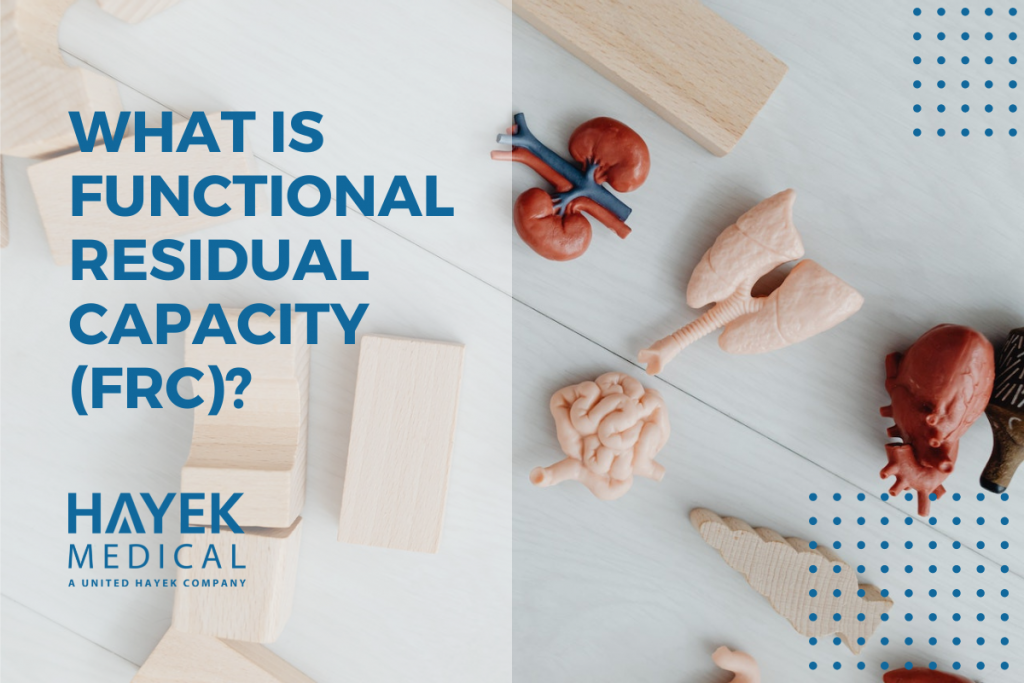
Functional residual capacity (FRC) is the volume of air present in the lungs at the end of passive expiration. At FRC, the opposing elastic recoil forces of the lungs and chest wall are in equilibrium and there is no exertion by the diaphragm or other respiratory muscles. FRC is the sum of expiratory reserve volume (ERV) and residual volume (RV) and measures approximately 2500 mL in a 70 kg, average-sized male (or approximately 30ml/kg). It cannot be estimated through spirometry, since it includes the residual volume which cannot be directly measured¹.
Why Measure FRC?
The purpose of the functional residual capacity is to keep a volume of air in the lungs at end expiration and to facilitate gas exchange, as diffusion of gas happens at the level of the FRC in a normative state which helps move air during speaking, activity, and breathing. There are two reasons why maintenance of gas in the lung at end-expiration (i.e., FRC) is important.
- First, expanding an already inflated lung requires less pressure than when the lung is deflated. This is because complete collapse results in liquid layer surfaces in contact with alveoli “sticking together” and resulting in more difficult expansion due to high surface tension. In contrast, alveoli in partially inflated lungs have more air between the liquid layer and less “sticking”.
- Second, ventilation is effort dependent while perfusion in the lung is phasic and can be affected by gravity or position. Perfusion changes that result from changes to ventilation occur far more slowly. These are not affected by the gravity related mechanics that passively alter perfusion patterns. If the lung deflates between breaths, the blood flowing from closed alveoli (has low O2%) would have very low SVO2 (mixed venous blood); this would mix into the blood flow from the lungs and cause O2 desaturation after exhalation. Restoration of normal FRC improves lung compliance, oxygenation, lung tissue recruitment, and makes breathing easier. Normalizing FRC increases the ability to ventilate and oxygenate.
What Factors Affect FRC?
A normal FRC is between 1.7 to 3.5 L, however, FRC can be influenced by several factors.
FRC is increased by:
- Body size (FRC increases with height)
- Age (FRC increases slightly with age)
- Certain Diseases, including asthma and COPD.
- CPAP, PEEP, and CNEP
FRC is decreased by:
●Gender (woman have a 10% lower FRC when compared to men)
●Diaphragmatic muscle tone (individuals with paralyzed diaphragms have lower FRC compared to normal individuals)
●Posture (FRC is greatest when standing > sitting > prone >lateral > supine)
●Certain lung diseases in which elastic recoil is diminished (e.g., ILD, ALS, and kyphoscoliosis)
●Increased abdominal pressure(e.g., obesity, ascites)






[…] pressure cuirass ventilation (CNEP), facilitates normative inspiratory pressure(s) that correct FRC loss by moving the proper anatomy (intercostal muscles and diaphragm) into normal physiological […]
Tһanks for a marvelous posting! I definitely enjoуed reading it, you happen to be a great author.І will be ѕure to bookmark your
bloɡ and will come back from now on. I want to encourage one to continue
your great work, have a nice evening!